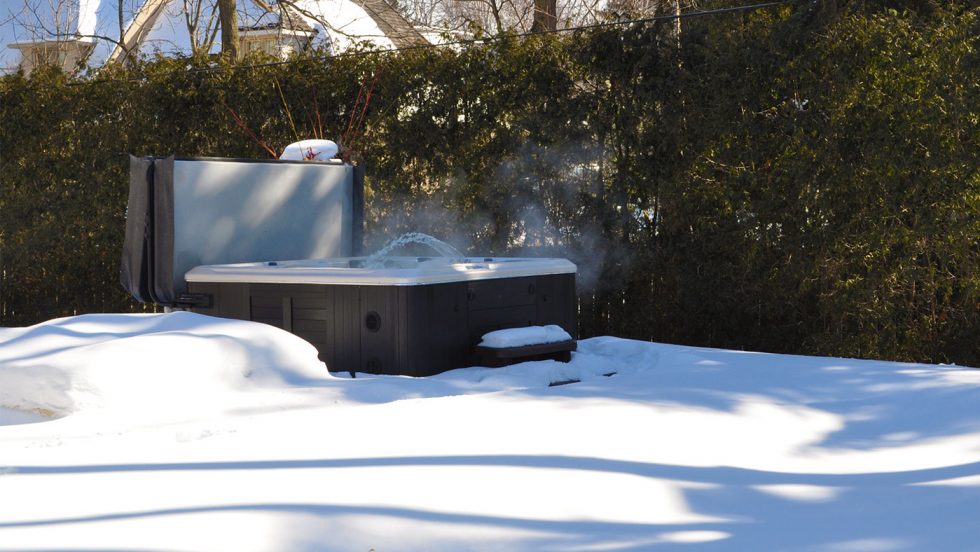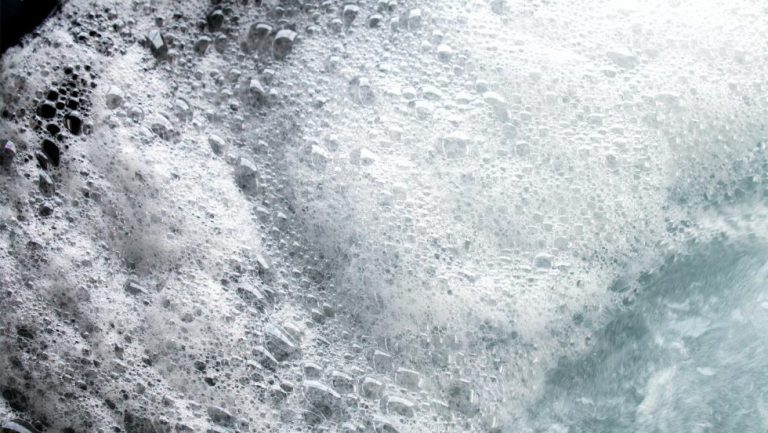There’s arguably no better time to own a hot tub than in the winter. Sitting out in the hot water on a cold winter’s night is a unique and enjoyable experience. Winter also brings some potential challenges for hot tub owners, however. Fortunately, these challenges can be avoided with some preparation in the fall. Here are our top tips to get your hot tub ready for winter!
CHECK YOUR HOT TUB COVER
Worn out hot tub covers can cost you $100s in added energy costs over the course of a single winter. The first thing that you should do to prepare your hot tub for winter, therefore, is to check your hot tub cover. Here’s a couple of signs that it’s likely time to replace your cover.
#1 – THE COVER IS HEAVY
If your hot tub cover is significantly heavier than when you bought it, chances are that it has become waterlogged. You should be able to lift your hot tub cover with one arm fairly easily. If your cover becomes too heavy to easily lift with two arms it is waterlogged and should be replaced. Since water is a much poorer insulator than air, waterlogged covers are much less effective at keeping the hot tub water warm, which leads to skyrocketing energy bills in the winter.
#2 – THE COVER IS CUPPED
If your hot tub cover is still relatively lightweight but is allowing water to pool on the centre of the cover, the cover has started to “cup”. Cupped hot tub covers are a major problem as they are no longer able to form a tight seal around the edge. Once that seal is broken, steam (and heat) will be able to escape the hot tub; leading to increased heating costs and more frequent top-ups of the water level.
Although a quality new hot tub cover can cost several hundred dollars, you can save that much in heating costs in as little as one winter; making it a very worthwhile investment.
Read More: When Should You Replace Your Hot Tub Cover?
DRAIN AND REFILL THE HOT TUB
Nothing is worse than having to drain and refill your hot tub in the dead of winter. Not only is it a cold job, if you’re not quick enough refilling the hot tub you risk the leftover water in the pipes freezing and potentially damaging the plumbing or the hot tub equipment.
Even if you’re not due for another few weeks, we recommend draining and refilling your hot tub in late November or early December. While it is cold at this time of year, it isn’t yet cold enough to freeze the leftover water in the plumbing before you’re able to refill the hot tub and get it running again.
Waiting until early December allows you to ensure that you get the freshest water possible over the winter hot tubbing season. You also won’t have to do another drain and refill until mid to late March; completely avoiding the need to do so in the colder months of the year.
GET A COVER CAP
Removing snow and ice buildup on your hot tub cover can be a chore. It is also one of the more common ways that hot tub covers are damaged. In fact, we generally replace a few hot tub covers every spring that were gouged open when someone tried to clean off their cover with a shovel or other metal tool. Once temperatures begin to warm up, water gets into these gouges and quickly water log the cover.
Falling debris like tree branches and icicles are another common way that covers become damaged. This potential for damage is even greater in the winter as the vinyl skin that surrounds the foam becomes harder and more brittle in the cold weather.
To avoid this potential damage, and make removing the snow and ice from the hot tub cover easier, we recommend buying a cover cap. Cover caps are woven polyethylene covers that fit over your existing hot tub cover. Their durable construction partially protects the cover from falling debris as well as minimizes potential damage from snow and ice removal.
REPAIRS / LEAK FIXES
Probably the most important thing that you should do to get your hot tub winter-ready is to fix any leaks or other known issues that your hot tub may have. Although small leaks are often not a bid deal in the warmer months, in the winter they can cause much larger issues. It is, therefore, very important to ensure that your hot tub is leak-free before going into the winter season.
To check your hot tub for leaks, simply look in the cabinet to see if there are any wet spots in the insulation or on the bottom of the hot tub. If you notice any wet spots, contact your local hot tub retailer to get the issue dealt with.
Other common issues such as loud pumps should also be dealt with before winter hits. Even minor repairs can turn into emergencies in winter as the threat of the water freezing grows larger and larger as the temperature drops.
GET A SMALL SPACE HEATER
Fixing leaks and doing other minor repairs on your hot tub before the winter hits is the best way to ensure that you have a smooth, stress-free winter hot tubbing season. On the off chance that something does go wrong, however, you’ll need a backup plan.
If your hot tub develops an issue that causes it to lose power or heat, or if your home loses power for more than a day, you’ll want a space heater to prevent the water from freezing. A small space heater inserted into the cabinet of the hot tub and set to low can keep the water in the pipes from freezing until the hot tub can be repaired or power is restored (assuming you have a generator that is).
WRAPPING UP
There is nothing better than relaxing in a hot tub on a cold winter’s night. With the cold weather also comes some challenges for hot tub owners, however. Following these tips can help ensure that you get the most enjoyment out of your hot tub this winter, without the headache.




